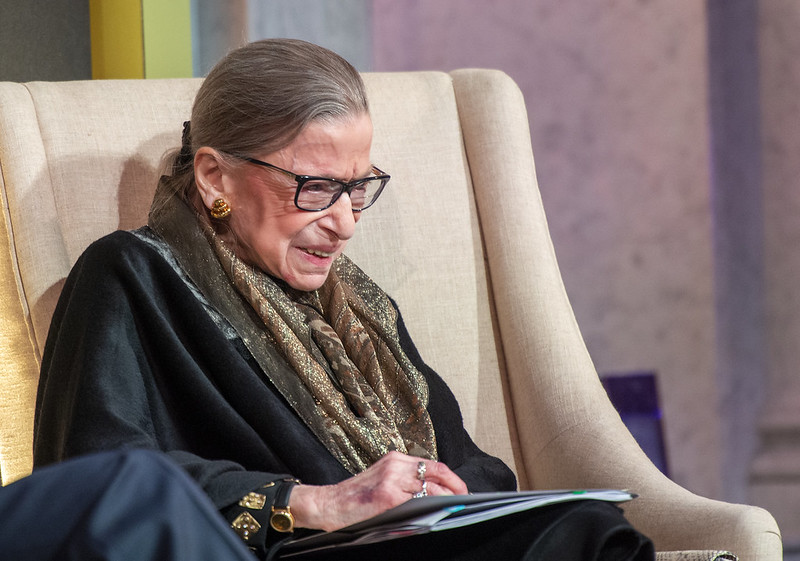Ruth Bader Ginsburg is a Household Name & Legacy
May 3, 2023
Former Associate Justice of the Supreme Court of the United States, Ruth Bader Ginsburg, was, and still remains a renowned and inspiring woman who successfully fought for equality for all. Ruth Bader Ginsburg is known for being a well qualified, diverse judge and person. Ginsburg’s legacy is one that should be remembered.
Ruth Bader Ginsburg, born Ruth Joan Bader, was born on March 15th, 1933 in Brooklyn, New York to Celia and Nathan Bader. Ruth’s mom Celia always encouraged Ruth as a little girl to have great ambitions. She would take Ruth to the library every week to keep her supplied with books. Ruth attended James Madison High School. While she was in school her mother Celia struggled with cancer, and eventually died soon before Ruth’s graduation day. After graduating, Ruth attended Cornell University, where she earned a bachelor’s degree with high honors in government and distinction in all subjects. Along with her academics, Ruth also met her husband at Cornell, Martin Ginsburg. They were married shortly after Ruth’s graduation and lived in Fort Sill, Oklahoma, where Martin completed his military service. Following his discharge, he started fulfilling legal studies at Harvard. The couple soon after had a baby named Jane, and about 14 months after her birth, Ruth entered Harvard Law School.
In her Harvard class of 500, Ruth was one of only nine women. She encountered resistance from some of her older faculty. While both Martin and her were attending Harvard, Martin was diagnosed with testicular cancer. During his illness, Ruth attended his classes, completed his work, and made sure it was turned in and up to date. With doing Martin’s work and the added responsibility of caring for a child, Ruth still managed to win a seat on the Harvard Law Review. Martin ended up making a full recovery and completed his studies. He then went on to join a law firm in New York City. In order to keep her family together, Ruth thought it was a good idea to transfer to Columbia for her last year of law school. While at Columbia, Ruth won a seat in the law review as well. Being on both law review’s, Ruth ended up graduating from Columbia tied for first in her class. Even though she was very academically strong, she faced many gender barriers. She interviewed for 12 separate law firms and got zero offers. In 1959, she was eventually offered a clerkship with Judge Edmund G. Palmieri of the U.S District Court for the Southern District of New York. Following this experience, she was offered jobs at major law firms, but declined and instead went back to Columbia to work on the law school’s Project on International Procedure.
In 1973 Ginsburg argued her first case before the Supreme Court. Following multiple complaints of gender inequality from the American Civil Liberties Union, she founded the ACLU’s Women’s Rights Project. Ginsburg continued to frequently present cases to the Supreme Court, arguing sex discrimination. One of the most important being Weinberger v. Wiesenfeld (1975). Her victory in this case was followed years later by another in Duren v. Missouri. After her victories, she earned a national reputation as a leading advocate for equality between men and women.
In 1980, President Jimmy Carter appointed Ruth Bader Ginsburg to the U.S Court of Appeals for the District of Columbia Circuit. After serving 13 years on the Court of Appeals, in 1993, President Bill Clinton appointed her to the Supreme Court of the United States. Ginsburg was only the second woman to be named to the Supreme Court, following Sandra Day O’Connor, and was the very first Jewish woman to serve. In her Senate confirmation hearings, Ginsburg was asked some controversial questions concerning her views on numerous political issues. She answered honestly and promised to maintain her open mindedness. The Senate confirmed her appointment 96 to 3.
One case that Ginsburg was directly involved in, that made a huge difference, was United States v. Virginia in 1996. In this case Ginsburg wrote the majority opinion, holding that qualified women could not be denied admission to Virginia Military Institute. While being involved with numerous cases, Ginsburg did struggle with some personal issues. In 1999 she was diagnosed with colon cancer. She underwent surgery, chemotherapy, and radiation, all without missing one day of service on the bench. Ten years later she was diagnosed with pancreatic cancer, and was back in the court after a successful surgery. On September 18th, 2020, Ruth Bader Ginsburg unfortunately passed away from complications within her pancreatic cancer. That evening, a crowd of her admirers gathered on the steps of the Supreme Court to pay tribute to an advocate for equal justice under the law.
Over the years Ruth Bader Ginsburg has been known and embraced by Americans as a feminist icon who always had it in her to fight for equality. She has been described as “courageous, tough, brave, moral, a fighter, and above all a winner.” Her life and work have been celebrated in books like The Notorious RBG, a 2015 biography, and the 2018 feature film On the Basis of Sex, which depicts her early life and her case Moritz v. Commissioner. Ruth Bader Ginsburg is and will continue to be an inspiration for women, and will go down in history as one of the best leading ladies.
